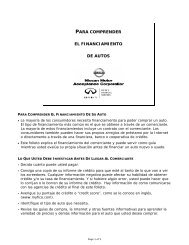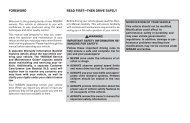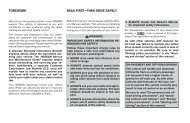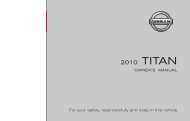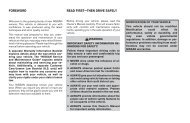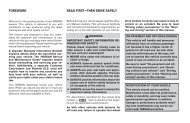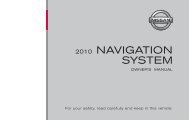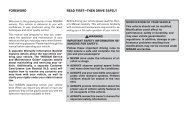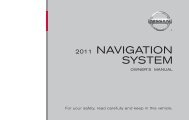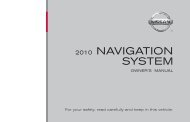You also want an ePaper? Increase the reach of your titles
YUMPU automatically turns print PDFs into web optimized ePapers that Google loves.
metal parts (antenna, etc.) on the<br />
windows. This may cause poor reception<br />
of the signals from the tire<br />
pressure sensors, and the TPMS will<br />
not function properly.<br />
Some devices and transmitters may temporarily<br />
interfere with the operation of the TPMS and<br />
cause the low tire pressure warning light to<br />
illuminate. Some examples are:<br />
. Facilities or electric devices using similar<br />
radio frequencies are near the vehicle.<br />
. If a transmitter set to similar frequencies is<br />
being used in or near the vehicle.<br />
. If a computer (or similar equipment) or a DC/<br />
AC converter is being used in or near the<br />
vehicle.<br />
FCC Notice:<br />
Changes or modifications not expressly<br />
approved by the party responsible for<br />
compliance could void the user’s authority<br />
to operate the equipment.<br />
This device complies with Part 15 of the<br />
FCC Rules and RSS-210 of Industry Canada.<br />
Operation is subject to the following two<br />
conditions: (1) This device may not cause<br />
harmful interference, and (2) this device<br />
must accept any interference received,<br />
including interference that may cause undesired<br />
operation of the device.<br />
AVOIDING COLLISION AND ROLL-<br />
OVER<br />
WARNING<br />
Failure to operate this vehicle in a safe<br />
and prudent manner may result in loss<br />
of control or an accident.<br />
Be alert and drive defensively at all times. Obey<br />
all traffic regulations. Avoid excessive speed,<br />
high speed cornering, or sudden steering<br />
maneuvers, because these driving practices<br />
could cause you to lose control of your vehicle.<br />
As with any vehicle, a loss of control could<br />
result in a collision with other vehicles or<br />
objects, or cause the vehicle to rollover,<br />
particularly if the loss of control causes the<br />
vehicle to slide sideways. Be attentive at all<br />
times, and avoid driving when tired. Never drive<br />
when under the influence of alcohol or drugs<br />
(including prescription or over-the-counter<br />
drugs which may cause drowsiness). Always<br />
wear your seat belt as outlined in the “SEAT<br />
BELTS” in the “1. Safety — Seats, seat belts and<br />
supplemental restraint system” section of this<br />
manual, and also instruct your passengers to do<br />
so.<br />
Seat belts help reduce the risk of injury in<br />
collisions and rollovers. In a rollover crash, an<br />
unbelted or improperly belted person is<br />
significantly more likely to be injured or<br />
killed than a person properly wearing a<br />
seat belt.<br />
ON-PAVEMENT AND OFF-ROAD<br />
DRIVING PRECAUTIONS<br />
Utility vehicles have a significantly higher<br />
rollover rate than other types of vehicles.<br />
They have higher ground clearance than passenger<br />
cars to make them capable of performing<br />
in a variety of on-pavement and off-road<br />
applications. This gives them a higher center of<br />
gravity than ordinary cars. An advantage of<br />
higher ground clearance is a better view of the<br />
road, allowing you to anticipate problems.<br />
However, they are not designed for cornering<br />
at the same speeds as conventional passenger<br />
cars any more than low-slung sports cars are<br />
designed to perform satisfactorily under off-road<br />
conditions. If at all possible, avoid sharp turns or<br />
abrupt maneuvers, particularly at high speeds.<br />
As with other vehicles of this type, failure to<br />
operate this vehicle correctly may result in loss<br />
of control or vehicle rollover. Seat belts help<br />
reduce the risk of injury in collisions and<br />
rollovers. In a rollover crash, an unbelted or<br />
improperly belted person is significantly more<br />
Starting and driving 5-5



